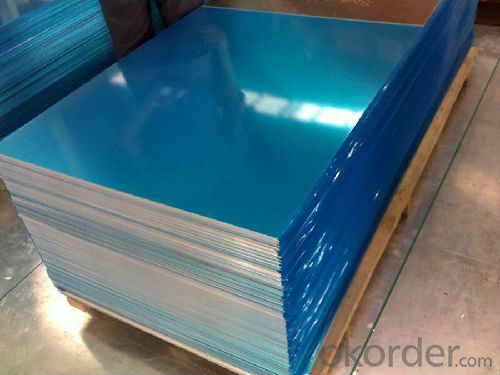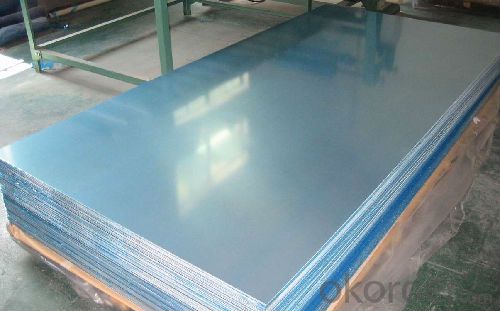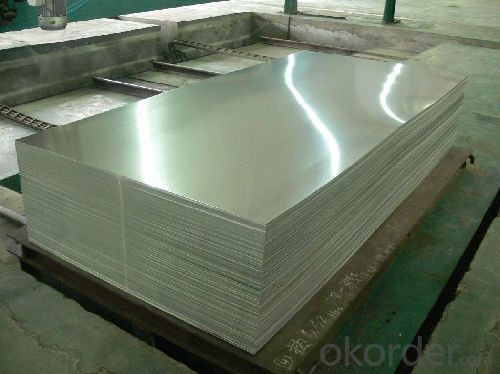Mill Finined Aluminum Sheets 8xxx
- Loading Port:
- China Main Port
- Payment Terms:
- TT or LC
- Min Order Qty:
- 5 m.t.
- Supply Capability:
- 100000 m.t./month
OKorder Service Pledge
OKorder Financial Service
You Might Also Like
1.Structure of Mill Finined Aluminum Sheets 8xxx Description
Mill Finined Aluminum Sheets 8xxx is cut from aluminum coils 8xxx.. It has great ductility, heat conductivity, anti-corrosion and moisture resistance properties.
Mill Finined Aluminum Sheets 8xxx is clean, flat, no wrinkle, no scratch, oil free, widly used in construction /Furniture/decorate/industry,etc.
2.Main Features of Mill Finined Aluminum Sheets 8xxx
• excellent quality,good credit
• competitive price,comfortable service
• Goode mechanical property
3.Mill Finined Aluminum Sheets 8xxx Images



4.Mill Finined Aluminum Sheets 8xxx Specification
Alloy | AA8xxx (AA8011 etc.) |
Temper | H14, H16, H18, H22, H24, H26, H32, O/F |
Thickness | 0.2mm -- 100mm |
Width | 30mm -- 1700mm |
Standard | GB/T 3880-2006,ASTM |
5. FAQ of Mill Finined Aluminum Sheets 8xxx
A.What is the MOQ?
The MOQ for each size is 8 tons, because it is D.C quality.
B. Now which countries do you export your goods?
Now we export to South East Asia,Africa, North America,South America ect.
- Q:Can aluminum sheets be used for decorative or architectural purposes?
- Yes, aluminum sheets can be used for decorative or architectural purposes. Due to their lightweight, durability, and versatility, aluminum sheets are commonly used in architectural design and construction for applications such as cladding, roofing, facades, and decorative elements. They offer various finishes, patterns, and colors, making them suitable for enhancing the aesthetic appeal of both interior and exterior spaces. Additionally, aluminum sheets are resistant to corrosion and require minimal maintenance, making them a popular choice for decorative and architectural purposes.
- Q:Can aluminum sheets be used for air ducts?
- Indeed, air ducts can utilize aluminum sheets. Aluminum, known for its lightweight and durable characteristics, is frequently employed in air ducts. Its resistance to corrosion renders it a suitable option for HVAC systems. Air ducts are often constructed using aluminum sheets due to their malleability, enabling easy bending and shaping to meet specific dimensions. Moreover, aluminum boasts commendable thermal conductivity, ensuring efficient heat transfer within the ducts. Ultimately, opting for aluminum sheets in air ducts proves to be a pragmatic and efficient decision.
- Q:How does the aluminum plate manufacturer prevent the aluminum plate from scratching?
- Chaoyang aluminum manufacturers tell you that you can ask the manufacturer to cover the aluminum plate surface, to prevent aluminum plate scraping it!
- Q:Calculate the molar mass of the aluminum oxide. A 5.00g strip of aluminum is reacted in air, producing an oxide weighing 9.36g. Calculate the percent oxygen and aluminum in the compound.Calculate the % error for percent of aluminum calculated.
- molar mass.. .. molar mass Al2O3 = 2 x 26.98 + 3 x 16.00 = 101.96 g/mol mass %'s based on formula .. % Al in Al2O3 = (2 x 26.98 / 101.96) x 100% = ___ % .. % O in Al2O3 = (3 x 16.00 / 101.96) x 100% = ___ % mass % based on experimental data .. % Al in oxide = (5.00g / 9.36g) x 100% = ___% .. % O in oxide = ( (9.36g - 5.00g) / 9.36g) x 100% = __ % and finally .. % error = (|measured - accepted| / |accepted|) x 100% = ___% ********* here's the answer for the ALUMINUM calcs .. % Al in Al2O3 = (2 x 26.98 / 101.96) x 100% = 52.92% .. % Al in oxide = (5.00g / 9.36g) x 100% = 53.42% .. % error = ( | 53.42% - 52.92% | / | 52.92% | ) x 100% = 0.95% you get to do the oxygen calcs
- Q:What are the different methods for finishing the edges of aluminum sheets?
- There are several methods for finishing the edges of aluminum sheets, depending on the desired outcome and application. One common method is edge trimming, which involves removing excess material from the edges of the sheet to achieve a smooth and straight edge. This can be done using various tools such as shears, saws, or routers. Another technique is edge deburring, which is used to remove any sharp or rough edges left after cutting. This is often done using sanding or grinding tools to smooth out the edges and create a more polished finish. Additionally, edge rolling is a method used to create rolled or rounded edges on aluminum sheets. This can be achieved through a rolling machine that applies pressure to the edges, bending them to the desired shape. For a more decorative finish, edge profiling can be employed. This involves using specialized tools or machines to create custom edge shapes or designs on the aluminum sheet. It allows for unique and aesthetically pleasing edges that can enhance the overall appearance of the sheet. Lastly, edge painting or coating is an option to consider. This process involves applying a protective or decorative paint or coating to the edges of the aluminum sheet. This not only provides a finished look but also helps to protect the edges from corrosion or other damage. Overall, the choice of method for finishing the edges of aluminum sheets depends on factors such as the intended use, desired appearance, and specific requirements of the project.
- Q:How do aluminum sheets perform in terms of heat reflectivity?
- Aluminum sheets have excellent heat reflectivity properties. They efficiently reflect heat and radiation, making them suitable for various applications that require heat insulation or management.
- Q:Can aluminum sheets be used for battery enclosures?
- Indeed, battery enclosures can utilize aluminum sheets. Aluminum proves to be a highly favored material for battery enclosures owing to its remarkable properties. Its lightweight nature, resistance to corrosion, and commendable conductivity render it an appropriate choice for safeguarding batteries and guaranteeing their optimal functionality. Furthermore, the exceptional strength-to-weight ratio of aluminum permits the creation of robust yet lightweight enclosures, making it an ideal selection for diverse battery applications. Moreover, the recyclability of aluminum adds to its appeal as an eco-friendly alternative. In conclusion, aluminum sheets serve as a feasible and frequently employed material for battery enclosures.
- Q:How do you achieve a mirror-like finish on aluminum sheets?
- Achieving a mirror-like finish on aluminum sheets involves a series of steps to remove any imperfections and create a smooth, reflective surface. Here are the key processes involved: 1. Surface preparation: Start by thoroughly cleaning the aluminum sheet to remove any dirt, grease, or other contaminants using a mild detergent and water. Rinse and dry the surface completely. 2. Sanding: Use progressively finer grits of sandpaper or abrasive pads to remove any scratches, oxidation, or roughness on the aluminum surface. Begin with a coarser grit (around 120-180) and gradually move to finer grits (up to 1000 or higher) to achieve a smoother finish. Sanding should be done in a consistent direction to avoid creating visible scratches. 3. Polishing compounds: Apply a polishing compound or metal polish designed specifically for aluminum surfaces. Use a soft cloth or a buffing wheel to apply the polish and work it into the surface. Apply gentle pressure and move in circular motions to evenly distribute the polish. Repeat this step until the desired level of shine is achieved. 4. Buffing: Use a buffing wheel, preferably made of felt or cotton, to further enhance the shine. Apply a small amount of a high-quality polishing compound to the wheel and carefully buff the aluminum sheet in a consistent manner. Again, use circular motions and maintain a steady, even pressure. 5. Final polishing: To achieve a mirror-like finish, use a specialized aluminum polish or a metal finishing compound. Apply a small amount onto a clean cloth and gently rub the surface in circular motions. This final step helps remove any fine scratches or imperfections, adding a brilliant shine to the aluminum sheet. Remember to clean the aluminum sheet thoroughly after each step to remove any residue or excess polish. Additionally, always follow the manufacturer's instructions when using specific polishing compounds or tools, as they may have specific guidelines for optimal results. By following these steps carefully and patiently, you can achieve a mirror-like finish on aluminum sheets, transforming them into highly reflective surfaces that are both visually appealing and functional.
- Q:Are aluminum sheets suitable for aviation applications?
- Indeed, aviation applications can make effective use of aluminum sheets. The aviation industry extensively employs aluminum owing to its lightweight nature, impressive strength-to-weight ratio, and ability to resist corrosion. Aluminum finds applications in the manufacturing of aircraft, including critical components like the fuselage, wings, and structural elements. By utilizing aluminum sheets, the aircraft not only gain structural integrity but also experience reduced weight, thereby enhancing fuel efficiency and overall performance. Furthermore, the versatility of aluminum sheets allows for easy shaping and fabrication, making them highly adaptable for diverse aviation purposes.
- Q:Can aluminum plate protect against radiation?
- Two. A brief introduction to radiation:Radiation refers to electromagnetic energy from the source part from the field source and transmitted, then return to the source, energy by electromagnetic waves or particles (such as the Alfa particle, beta particle) in the form of outward diffusion. All objects in nature, as long as the temperature is above zero degrees of absolute temperature, send the heat continuously in the form of electromagnetic waves and particles. This way of transmitting energy is called radiation. The radiation energy radiates straight from the source outward in all directions. The energy emitted by an object through radiation is called radiant energy. The radiation was calculated by roentgen / hour (R). One important feature of radiation is that it is "peer"". A body can radiate radiation to a second object, and at the same time a radiation to a target, regardless of the temperature of the object (gas). The term is commonly used in ionizing radiation. Radiation itself is a neutral term, but radiation from certain substances can be harmful.
1. Manufacturer Overview |
|
|---|---|
| Location | |
| Year Established | |
| Annual Output Value | |
| Main Markets | |
| Company Certifications | |
2. Manufacturer Certificates |
|
|---|---|
| a) Certification Name | |
| Range | |
| Reference | |
| Validity Period | |
3. Manufacturer Capability |
|
|---|---|
| a)Trade Capacity | |
| Nearest Port | |
| Export Percentage | |
| No.of Employees in Trade Department | |
| Language Spoken: | |
| b)Factory Information | |
| Factory Size: | |
| No. of Production Lines | |
| Contract Manufacturing | |
| Product Price Range | |
Send your message to us
Mill Finined Aluminum Sheets 8xxx
- Loading Port:
- China Main Port
- Payment Terms:
- TT or LC
- Min Order Qty:
- 5 m.t.
- Supply Capability:
- 100000 m.t./month
OKorder Service Pledge
OKorder Financial Service
Similar products
New products
Hot products
Related keywords





























